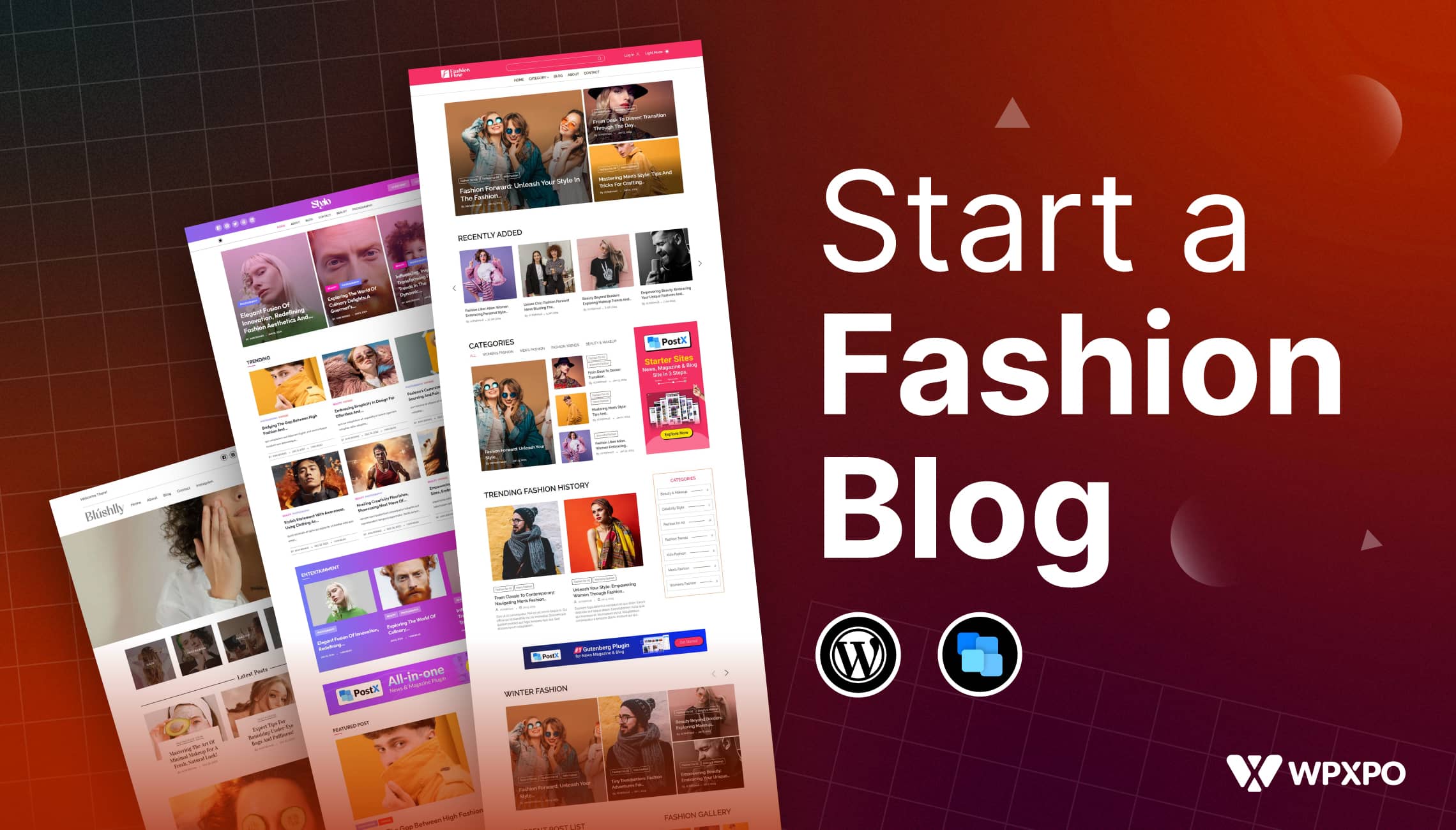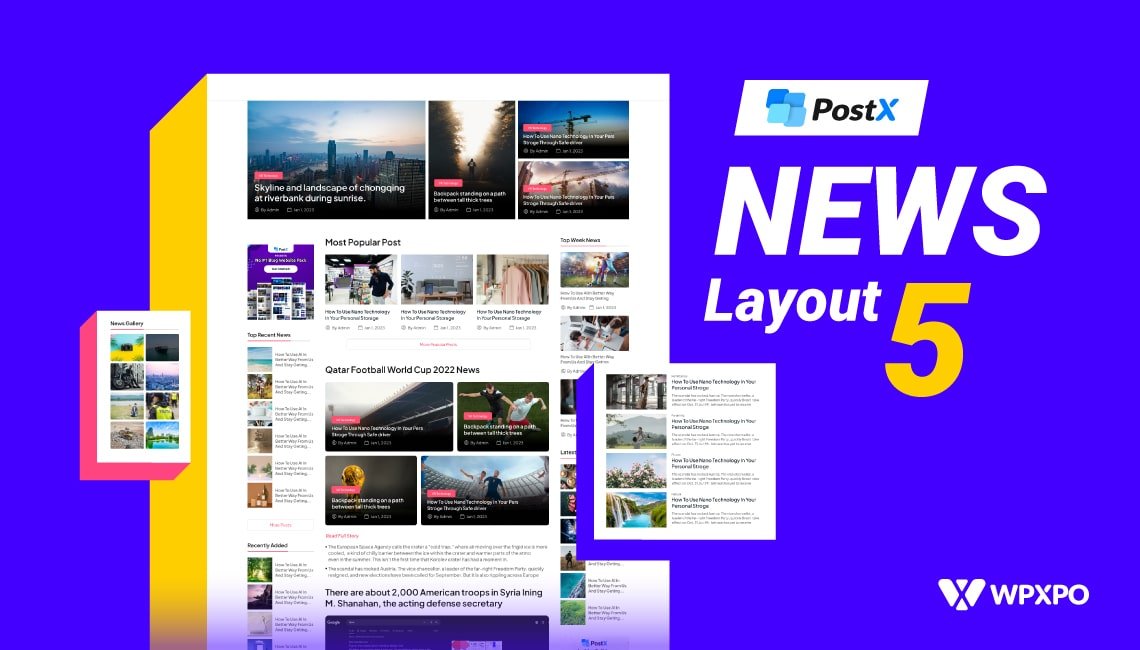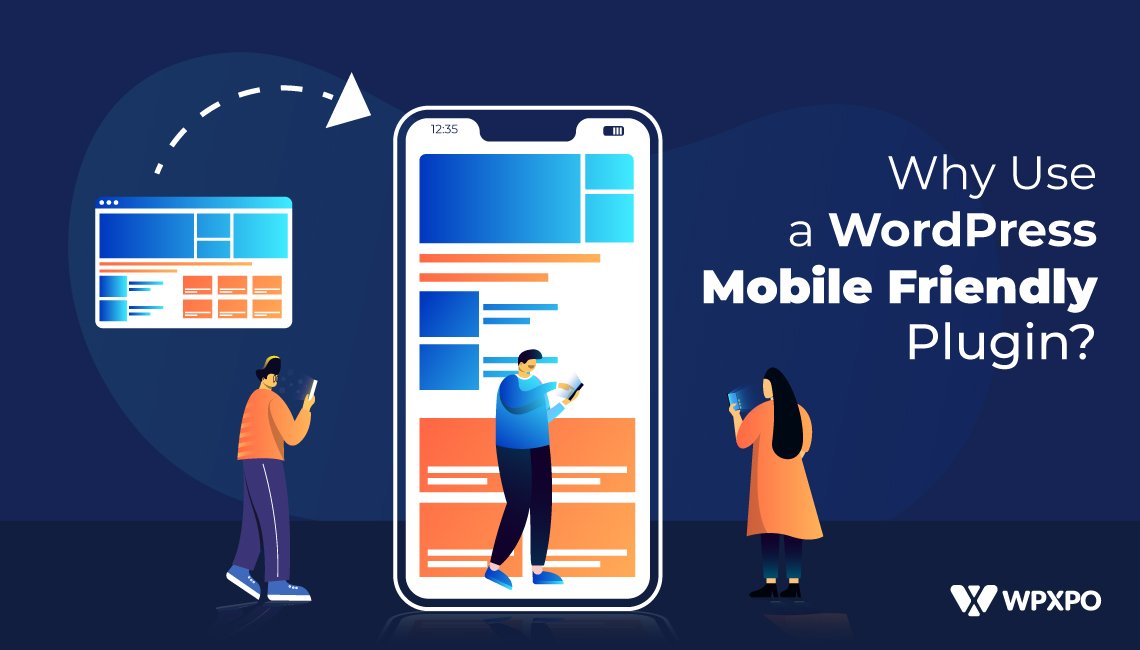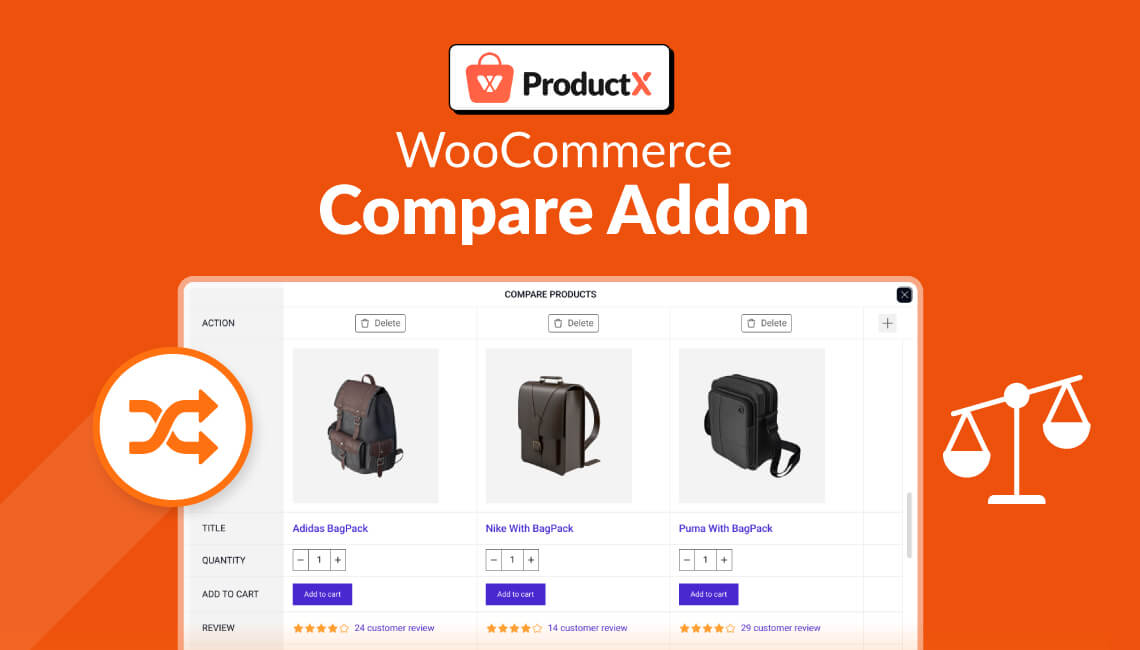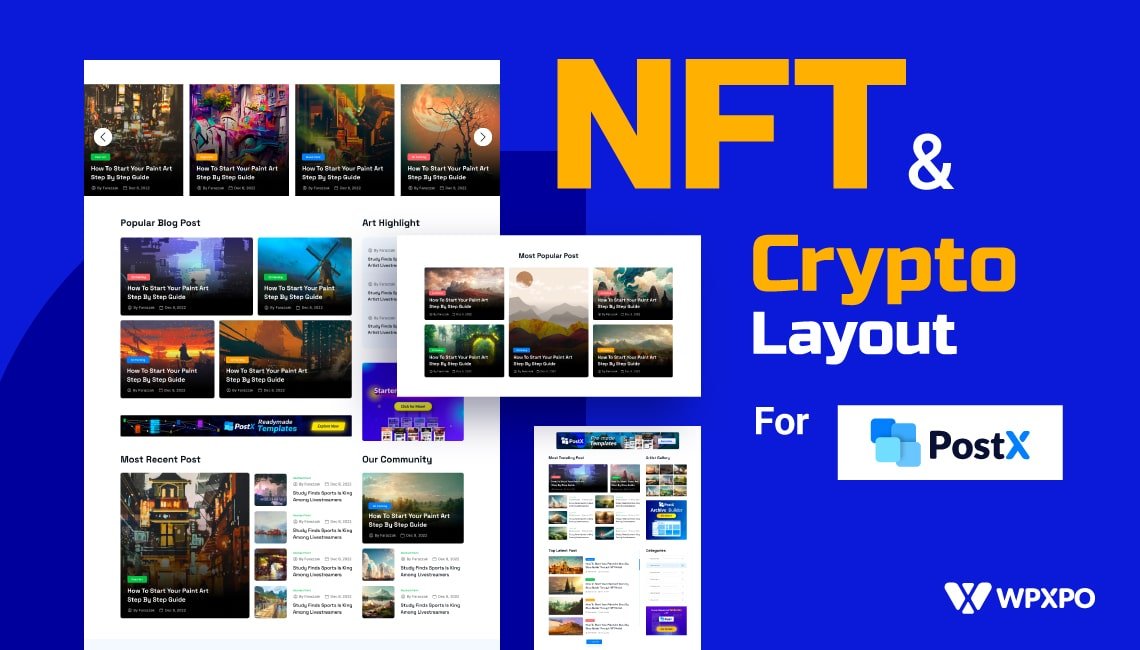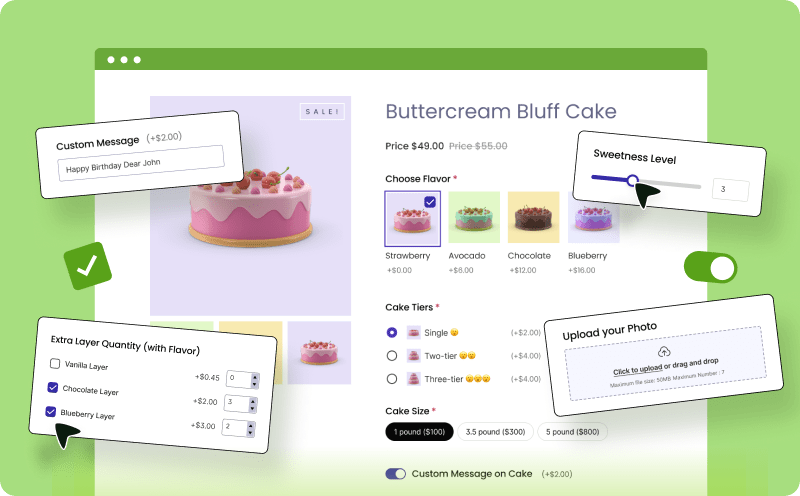Do you love fashion and stay on top of trends? You can follow your passion professionally.
Starting a fashion blog could be your gateway to a stylish and exciting career. It’s not just about showcasing your outfits; it’s about inspiring others to embrace their own style. Plus, you can build a rewarding career through fashion blogging.
Don’t worry if you’re new – I’ll walk you through every step of launching your fashion blog!
To start a fashion blog and make money, follow these steps:
- Choose Your Ideal Niche
- Brainstorm a Catchy Name and Logo
- Purchase Domain and Hosting
- Select a Blogging Platform
- Design and Customize Your Fashion Blog
- Prepare Your Content and Footage
- Build Your Audience and Engage with the Community
- Monetize Your Fashion Blog
- Follow Other Fashion Bloggers for Inspiration
For detailed guidance on each step, read the full article.
Key Takeaways
Come up with a unique name and logo for your fashion blog. Use creative tools to make it stand out.
Buy a domain and hosting by checking the provider’s reputation, security, features, and customer support.
Set up your fashion blog with PostX, a top Gutenberg Blocks builder plugin. Use starter sites for a quick start.
Create quality content and visuals that resonate with your audience’s fashion interests. Use best practices to enhance engagement.
Expand your audience on social media and other platforms.
Follow successful fashion bloggers to refine your skills and content.
Finally, Monetize by promoting products and brands, or offering fashion advice.
What Is A Fashion Blog & Why Should You Start One?
A fashion blog is a dedicated website where people share their thoughts and tips about style clothing and accessories.
For example, a blogger might review new fashion collections or show how to style a summer dress for different occasions.
Fashion blogs help readers stay updated on trends and find inspiration for their own wardrobes. Fashion bloggers often post about:
- latest trends
- outfit ideas
- Style tips
- Product Reviews
- Behind the Scenes and more.
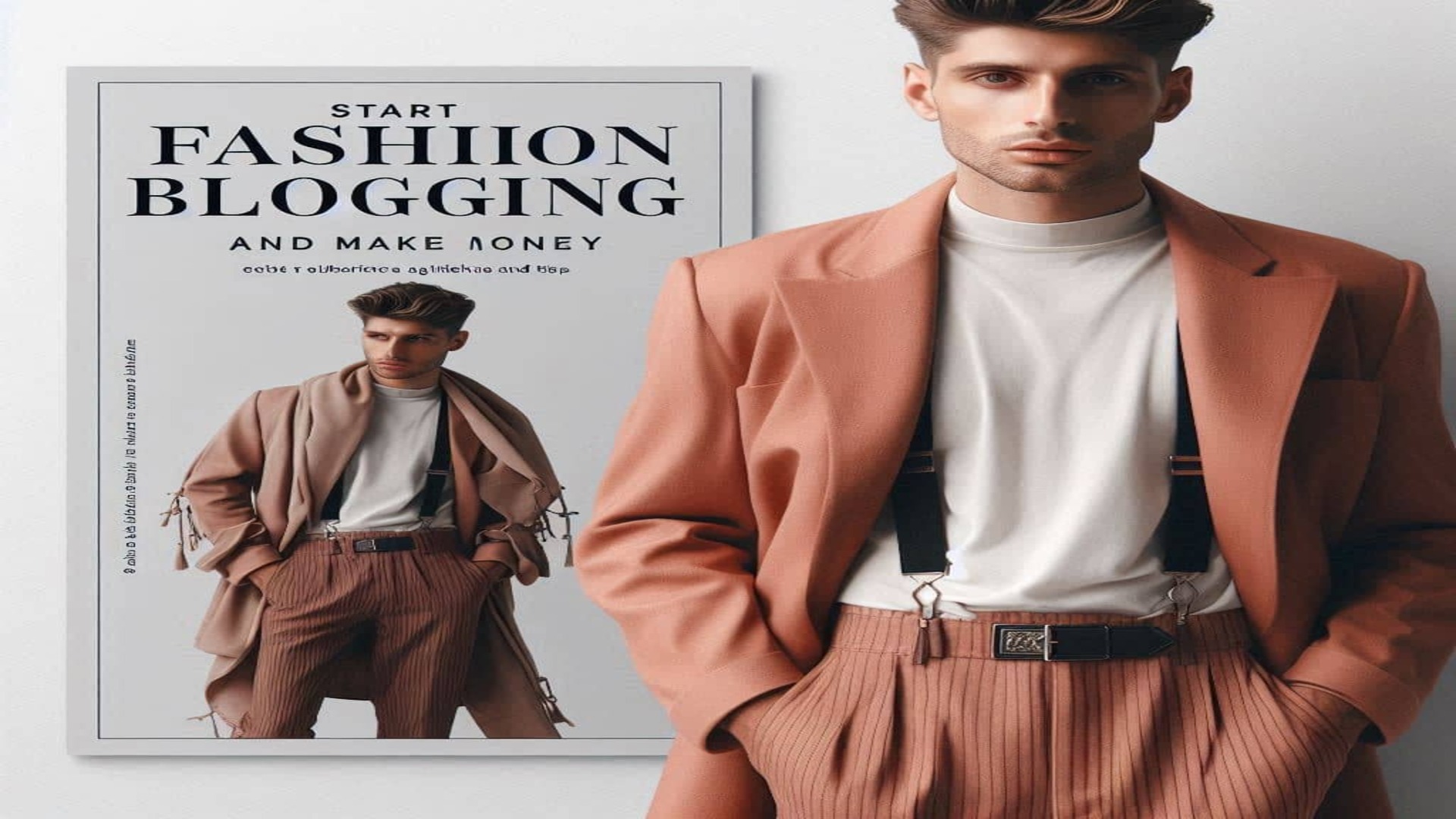
Why Start a Fashion Blog?
Starting a fashion blog can be a rewarding and fulfilling experience. Here are some reasons why you should consider it:
Become an Influencer: You can become a fashion influencer with consistent effort and dedication. This will help you create a unique identity that you can proudly share with the world.
Express Creativity: Fashion blogging is a great way to showcase your unique style and creativity. You can express your ideas through this blog and help people become more mindful.
Build a community: You can connect with like-minded individuals who share your passion for fashion. This community will help you grow and encourage you to develop in your life.
Earn money: It’s a great way of earning a handsome amount. As a fashion blogger, you can monetize your blog through various methods, such as sponsored content, affiliate marketing, or selling products.
Advance Career: A fashion blog can help you build your portfolio and network within the fashion industry. This way, you can unlock new opportunities to be more experienced and professional.
Learn and Grow: You can explore the fashion industry, learn about trends, and develop your knowledge and skills. Plus, fashion blogging can improve your writing, photography, and editing abilities.
Remember: Starting a successful fashion blog takes time and effort. Be consistent with your content, engage with your audience, and have fun with the process!
How to Start A Fashion Blog (Step-by-Step)
Now that you know what a fashion blog is and why you should start one, it’s time to provide you with the detailed steps. Let’s dive in!
Step 01: Choose A Fashion Blog Niche
The first step in selecting a fashion blog niche is identifying your interests. In the vast world of fashion blogs, finding your niche is essential for standing out and connecting with your audience.
You can consider the following questions to help you choose the right one:
- What aspects of fashion excite me?
- Am I drawn to specific styles, trends, or designers?
- Who are my target audiences?
- What message do I want to share with the world?
- Which topics am I comfortable talking about?
- Can I share something unique in my chosen niche?
- Is there already a lot of competition in my chosen niche?
These questions will help you pick the exact niche and simplify the money-making process through fashion blogging.
There’s always an audience for any fashion blog niche. Here are some ideas you can start with:
- Street Style: Capture and analyze the latest fashion trends on the streets.
- Celebrity Fashion: Focus on the outfits of famous people.
- Vintage Fashion: Explore retro styles and timeless styles.
- Sustainable Fashion: Promote eco-friendly and ethical fashion styling.
- Minimalist Fashion: Highlight simplicity and clean style sense.
- Gothic Fashion: Dive into dark and mysterious aesthetics.
- Men’s Fashion: Focus on men’s grooming and styles.
- Women’s Fashion: Focus on women’s grooming and styles.
- Teen Fashion: Provide tips and trends for young people.
- DIY Fashion: Make your own clothing and customization ideas.
- Fashion News Blog: Share fashion-related news in your blog.
- Budget-friendly Fashion: Offer affordable fashion hacks.
Step 02: Brainstorm an Engaging Name and Logo
To create a unique brand identity, you should start with a unique name and logo. During brainstorming, consider your brand’s target audience and core message.
Pick a name that’s easy to pronounce, and sticks in people’s minds. For the logo, opt for a clean and original design. Customize the colors and shapes to align with your brand’s personality.
Use these brainstorming techniques:
Mind Mapping: Start with your main theme, like “fashion blog.” Branch out to related words such as “style,” “trends,” “outfits,” “accessories,” and “wardrobe.” You can use these words to inspire ideas for your blog’s name and logo.
Word Matching: Pair related words side by side to create a unique name. Try starting with different letters of the alphabet.
Competitor Analysis: Analyze leading competitors to identify trends in their brand names and logos.
Customer Surveys: Gather insights from your target audience on their preferences and expectations.
Consider these guidelines when choosing a brand name:
Brand Identity: Clearly define your brand’s personality, values, and audience.
Availability: Confirm that the domain name and social media handles are available.
Positivity: Always choose a name that evokes positive feelings.
Future-proof: Pick a name that will remain relevant and appealing as your brand evolves.
Relevance: Ensure the name aligns well with your business and its offerings.
Memorability: Choose a name that’s simple to recall and spell. You can study your audience’s culture for this.
Tips: You can use free resources like Namelix or AI-driven platforms like ChatGPT to brainstorm ideas.
Tips for Creating a Strong Logo:
Simplicity: Keep the design clean and straightforward.
Visual Appeal: Ensure the logo is visually pleasing and matches your brand.
Color Psychology: Select colors that align emotionally with your audience.
Typography: Choose typography that reflects your brand’s unique character.
Symbolism: Include symbols or images that have meaning.
Scalability: Make sure your logo maintains its appeal across various devices.
With these tips and creativity, you can build a perfect brand identity. Make sure the name and logo fit together. Plus, they should look good on all platforms.
Step 03: Buy Domain and Hosting
Now you must choose the right domain name and a reliable hosting provider. Let’s briefly explain both.
A domain name is the address of your website. It’s what people type into their browsers to visit your site. It usually has two parts: the name and the extension.
For example, in “apple.com,” “apple” is the name, and “.com” is the extension. Domain names simplify complex numerical IP addresses into easy and memorable formats.
Web hosting is where your website lives. It is similar to how your home gives you a place to live. It provides space to store your site’s files and data and makes your website accessible on the internet.
A hosting provider manages server resources, maintains security, and keeps your site running smoothly.

Secure Your Domain
Using a .com extension is a good idea because it’s very popular. You could also use a .blog extension to make your blog unique. You should always consider buying your domain from well-known providers like NameCheap, PorkBun, GoDaddy, and others.
Select the Right Hosting Provider
Your journey starts with choosing a reliable hosting provider that meets your unique needs. You must begin by researching the hosting provider’s reputation and customer reviews. To make the process easier, here are some key factors to consider:
Upgradibility Options: As your website grows, you’ll need more resources. Make sure your hosting provider offers easy upgrade options. For example, moving from basic shared hosting to a more powerful VPS or dedicated server should be hassle-free.
Storage and Bandwidth: Consider how much storage space and bandwidth your website will require. For instance, if you plan to host videos or large image files, ensure the provider offers sufficient capacity to maintain speed and performance.
Control Panel: A simple control panel, like cPanel, makes managing your website easy. You don’t need to be tech-savvy for this. You should be able to handle tasks like setting up emails or managing databases without any trouble.
Security Features: You should always choose a hosting provider that prioritizes security. Look for features like SSL certificates, daily backups, and DDoS protection. These tools protect your website from hackers and help you recover quickly from any issues.
Uptime Guarantee: Downtime can damage your website’s reputation. Choose a hosting provider that offers at least 99.9% uptime. This way, your site will be available to users almost all the time.
24/7 Customer Support: Problems can occur at any time, so 24/7 customer support is a must. Always look for hosting providers that offer support via live chat, phone, or email, so you can get help whenever you need it.
Refund Policy: A transparent refund policy is important. You should always check if the provider offers a money-back guarantee within a set period. This allows you to test the service without committing long-term.
Extra Features: Consider additional benefits like free domain registration, automated backups, or built-in website builders. These can add value to your hosting package and make managing your website easier.
By keeping these factors in mind, you’ll be better equipped to select a hosting provider that supports your website’s growth and success. Good luck!
Step 04: Choose A Suitable Blogging Platform
Now that you know what to consider when buying a domain and hosting, the next step is to choose a blogging platform. A blogging platform helps you manage, edit, and publish your content effortlessly.
There are many blogging platforms, but I suggest using WordPress. It’s simpler and more convenient for creating a fashion blog.
Don’t just take my word for it—Let’s explore why WordPress is the best choice for your blog.
Why is WordPress Popular?
As of June 2024, WordPress powers 43.2% of all websites on the internet. It also holds a 63.3% share of the entire CMS market. Search Logistics covered all of this in detail.
Here’s why WordPress is so popular
Beginner-Friendly: With WordPress, even beginners can easily create and manage websites. There is no need for any coding knowledge. This accessibility encourages anyone to start building a website.
Free and Open Source: You can use WordPress for free. With a large community of developers, it remains secure and up-to-date. Its open-source nature means developers can modify it to fit their needs.
Highly Versatile: WordPress launched as a blogging platform, but it has evolved. Now, you can use it to build any kind of website. With its wide range of plugins and themes, you can build anything from a personal blog to a fully functional online store.
Extensive Plugin and Theme Library: WordPress offers a vast collection of plugins and themes. With these, you can enhance your website’s functionality and design. You can choose from thousands of free and premium options to suit your specific requirements.
SEO Friendly: WordPress is built with search engine optimization (SEO) in mind. It increases your website’s chances of ranking higher in search engine results. Additionally, various SEO plugins can further enhance your site’s visibility.
Scalable Freedom: No matter how much your business grows, WordPress can handle it. You can easily add more plugins and themes to meet your requirements.
Strong Community Support: If you face any issues, you can easily find plenty of online forums, tutorials, and documentation. There’s a vast community ready to help with any problems you might encounter.
Step 05: Design and Customize Your Fashion Blog
Now that you have a solid understanding of WordPress, it’s time to build an outstanding fashion blog.
There are several ways you can consider.
- You can customize a fashion blog theme.
- Or, you can use a plugin like PostX.
PostX is the leading Gutenberg Blocks Builder plugin in WordPress. It offers a vast library of pre-made blocks, templates, dynamic site builders, and useful add-ons. Beyond fashion blogs, you can also create news sites, magazine hubs, portals, and much more!
I suggest PostX for your fashion blog. With its Starter Sites, we can create a captivating fashion blog in just three simple steps.
We’ll begin by installing the latest version of PostX. Let’s get started!
I. Choose a Fashion Specific Template
Starter Sites helps you quickly start a web development project. They come with ready-made templates that include all the required pages and features. This helps save a lot of time and effort.
Let’s explore how it can benefit you with PostX. From WordPress Admin Dashboard, go to PostX > Starter Sites
Now, select the fashion category and pick any of the three available starter sites.
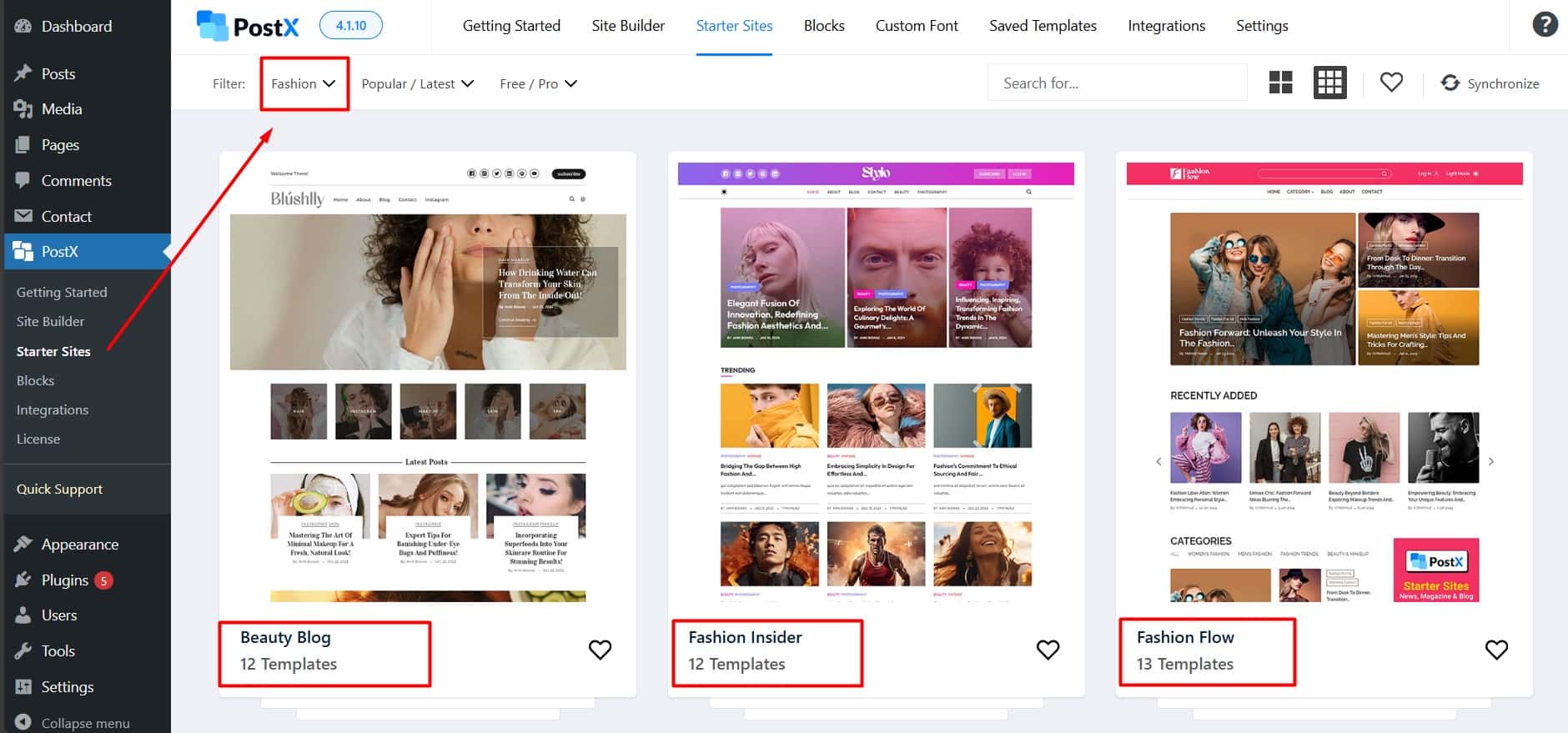
Check out all the amazing Starter Site templates by clicking on the link: Explore Starter Sites.
II. Personalize the Look
After picking a template, you’ll land on a page where you can customize the colors, fonts, and typography.
Select your preferred color or font from the options. This will ensure your fashion blog has a consistent look and feel.
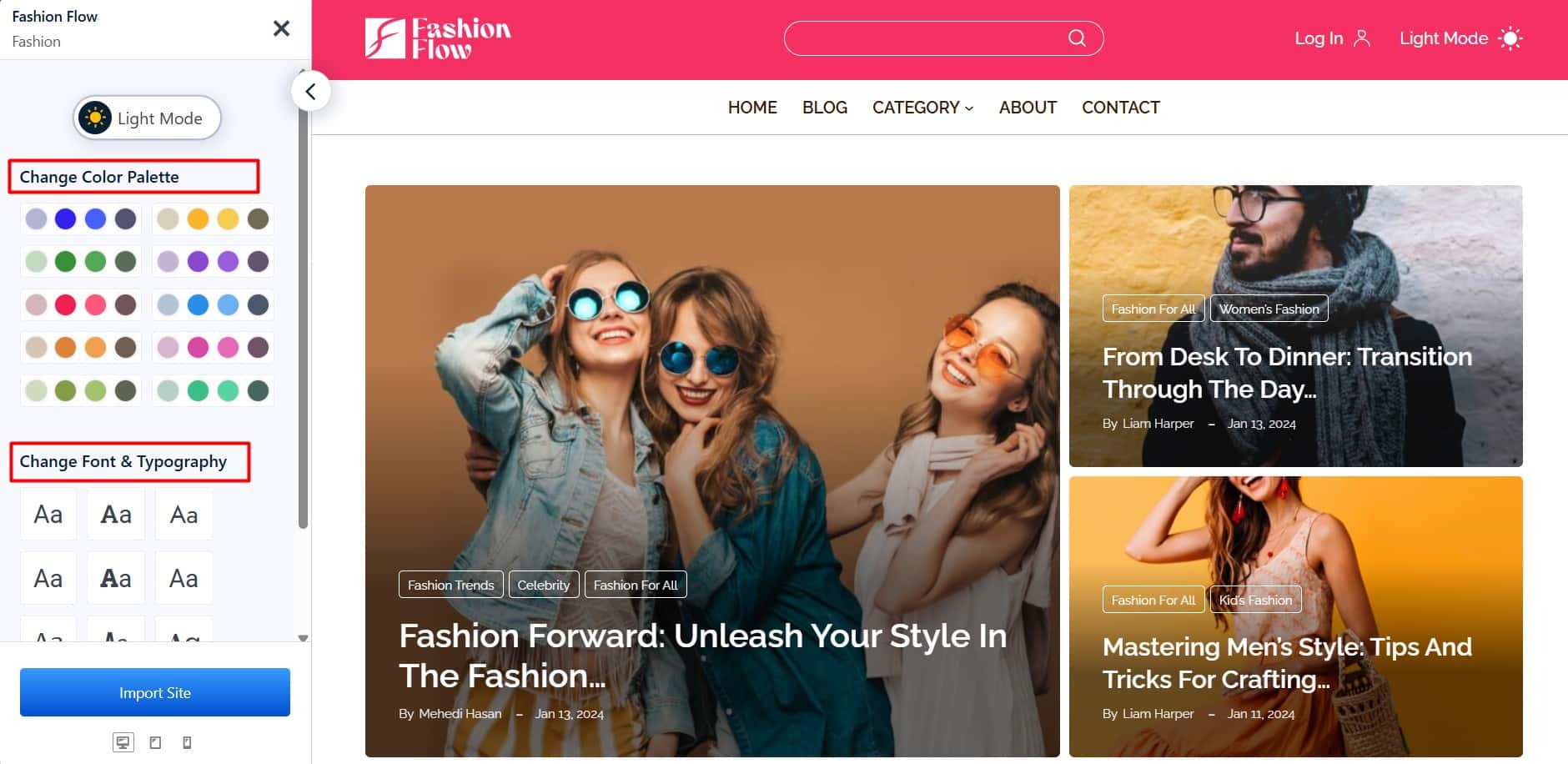
To make your site easier on your users’ eyes, you can activate dark mode here. Simply toggle the Light Mode switch and customize it as needed.
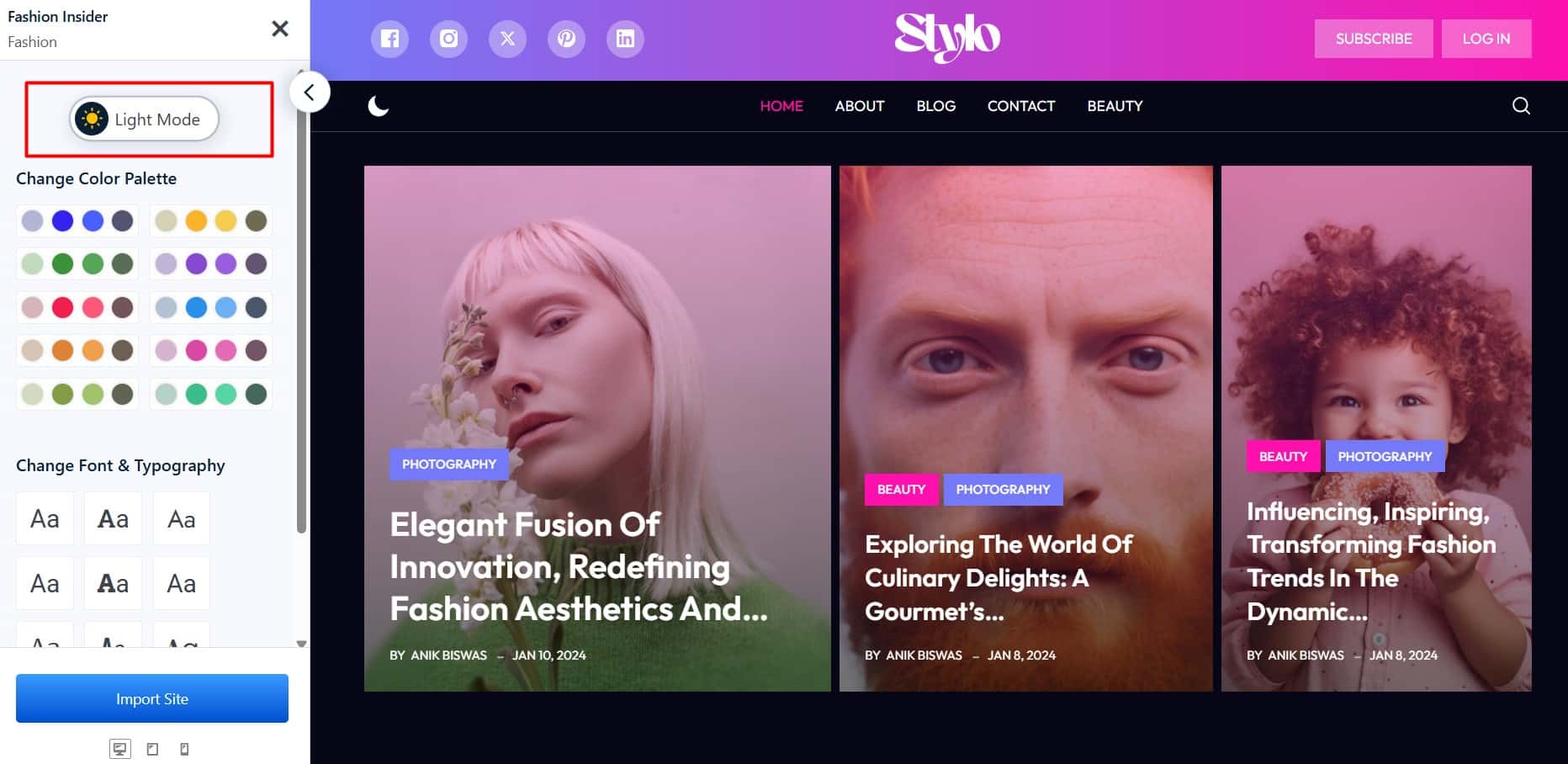
III. Import The Entire Site
Once you’ve chosen the color palette and typography, click on the Import Site option.
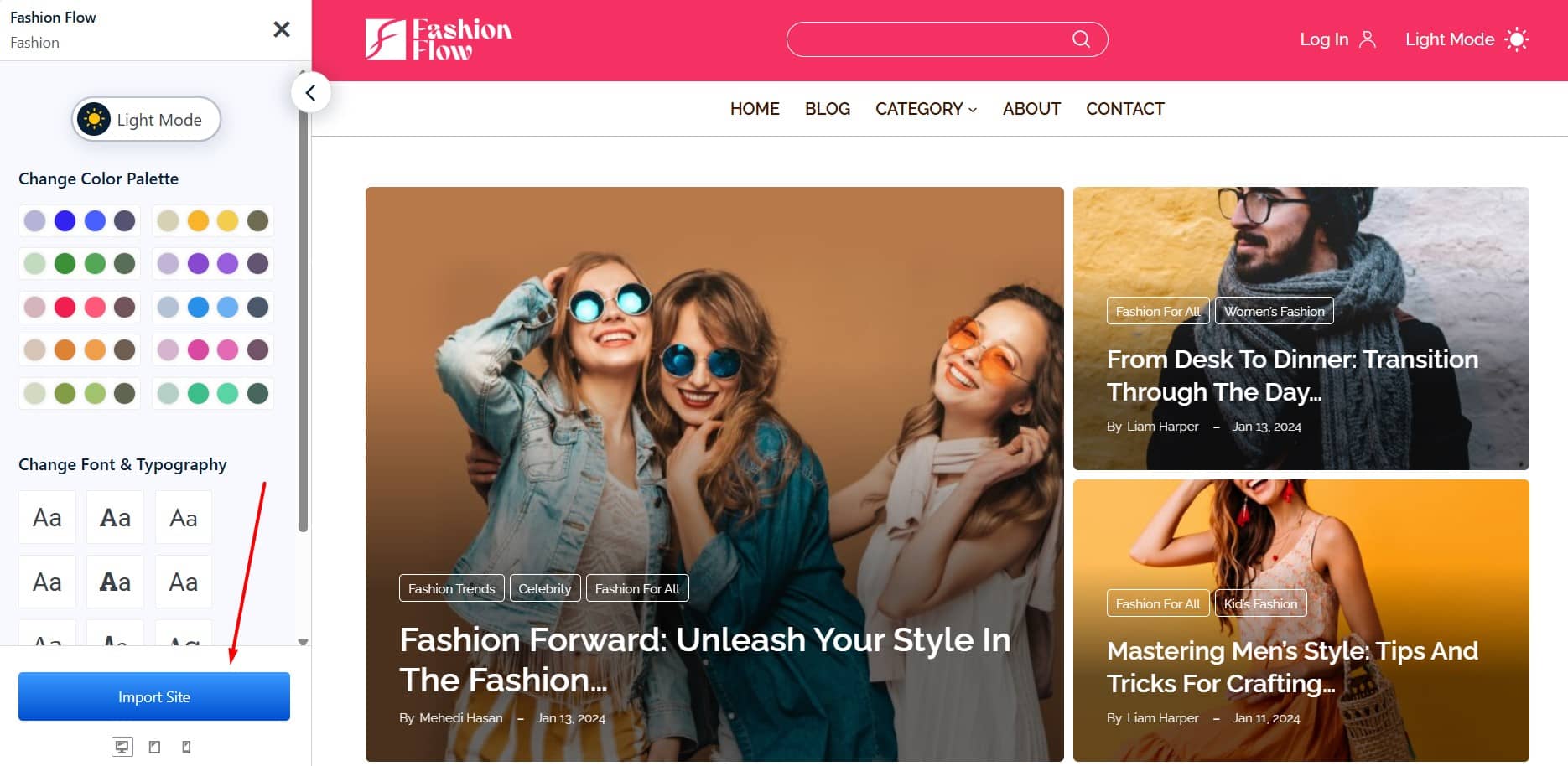
A popup will appear with Import Settings and Template options. In the import settings, you can choose to include dummy posts or not. You can remove previously imported sites and install necessary plugins directly from this popup.
After that, head over to Templates/Pages to select the templates or pages you want for your fashion blog.
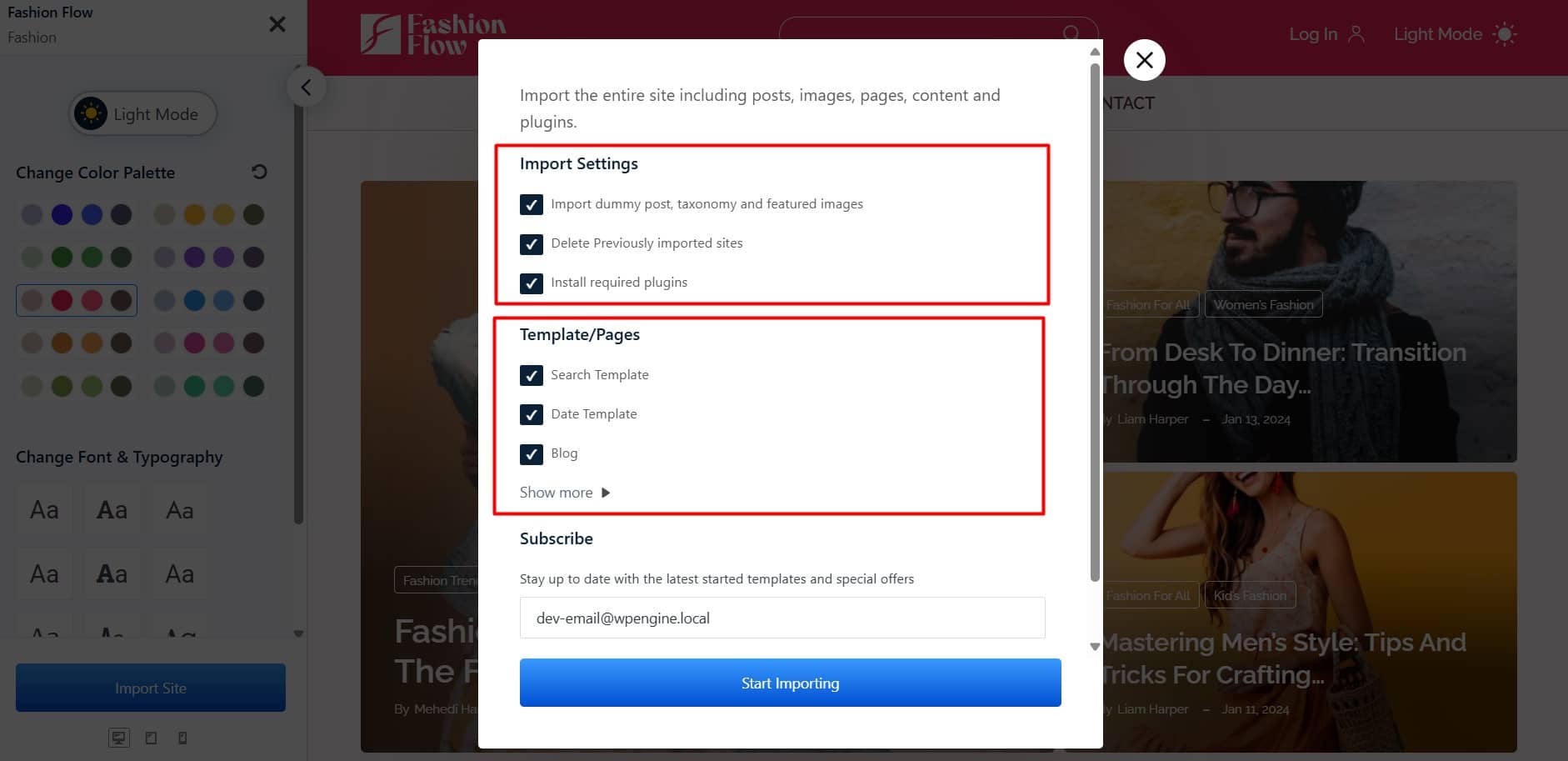
Click “Start Importing” after selecting your options. The process will begin, and you can relax while it is completed.
After the process is completed, your site will be equipped with all the necessary pages. You can further customize it.
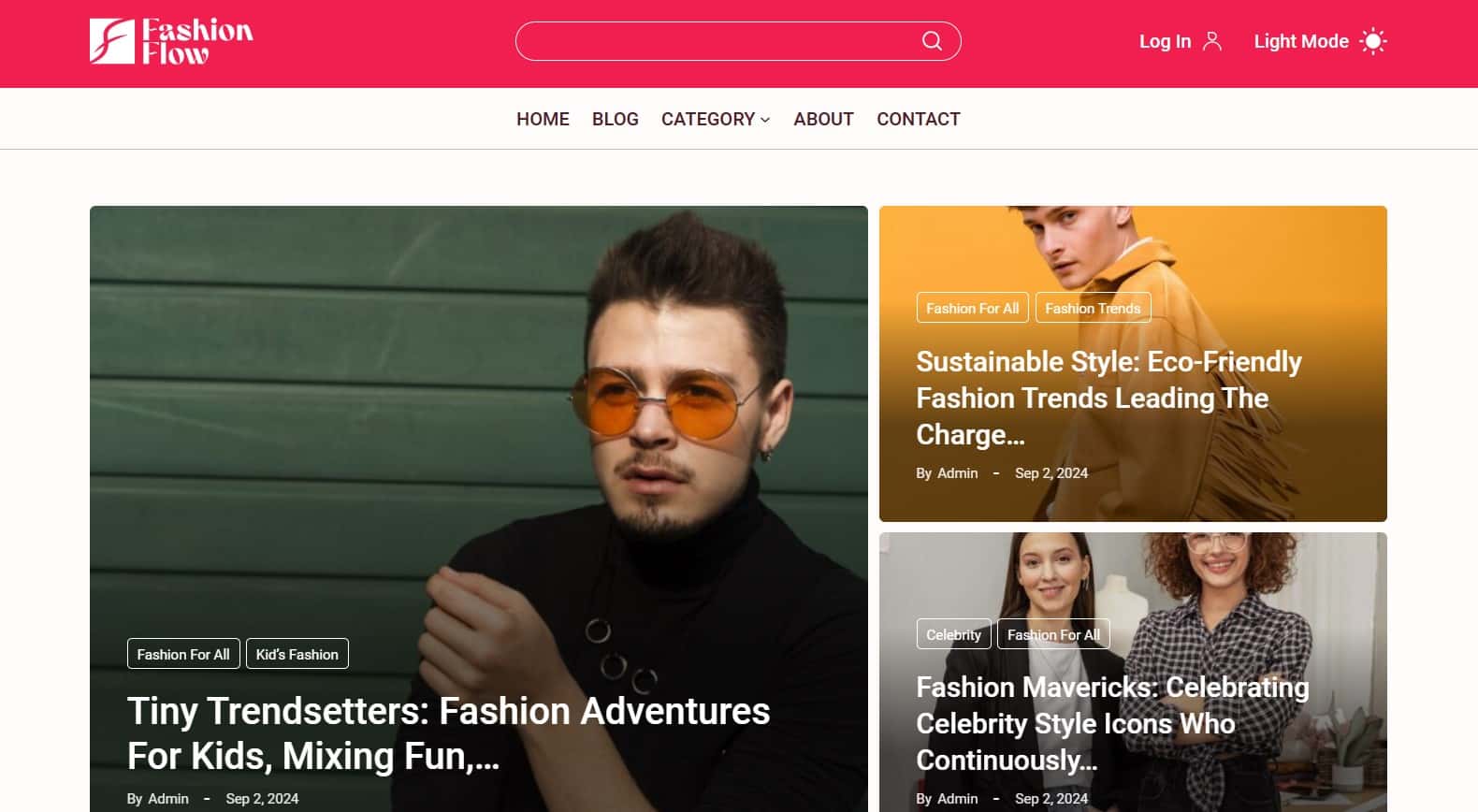
Now, you can see that the outcome looks professional and appealing. It will undoubtedly captivate visitors and make a strong impression. All the necessary elements are included, so you don’t have to start from zero. This is the fastest way to launch your fashion blog in just a few hours.
Watch our helpful video guide on starting a fashion blog.
Customize Your Fashion Blog with Site Builder
Once you’ve built your fashion blog site with PostX, you can easily fine-tune each section using its features.
One standout feature of PostX is the Site Builder. It lets you create custom post templates.
With these templates, you control how each page looks. You can even make specific posts stand out.
For example, to change how all blog posts appear on your fashion site, follow these steps:
- From your admin dashboard, go to PostX > Site Builder > Create Template > Singular
- Next, choose a premade template or create one from scratch.
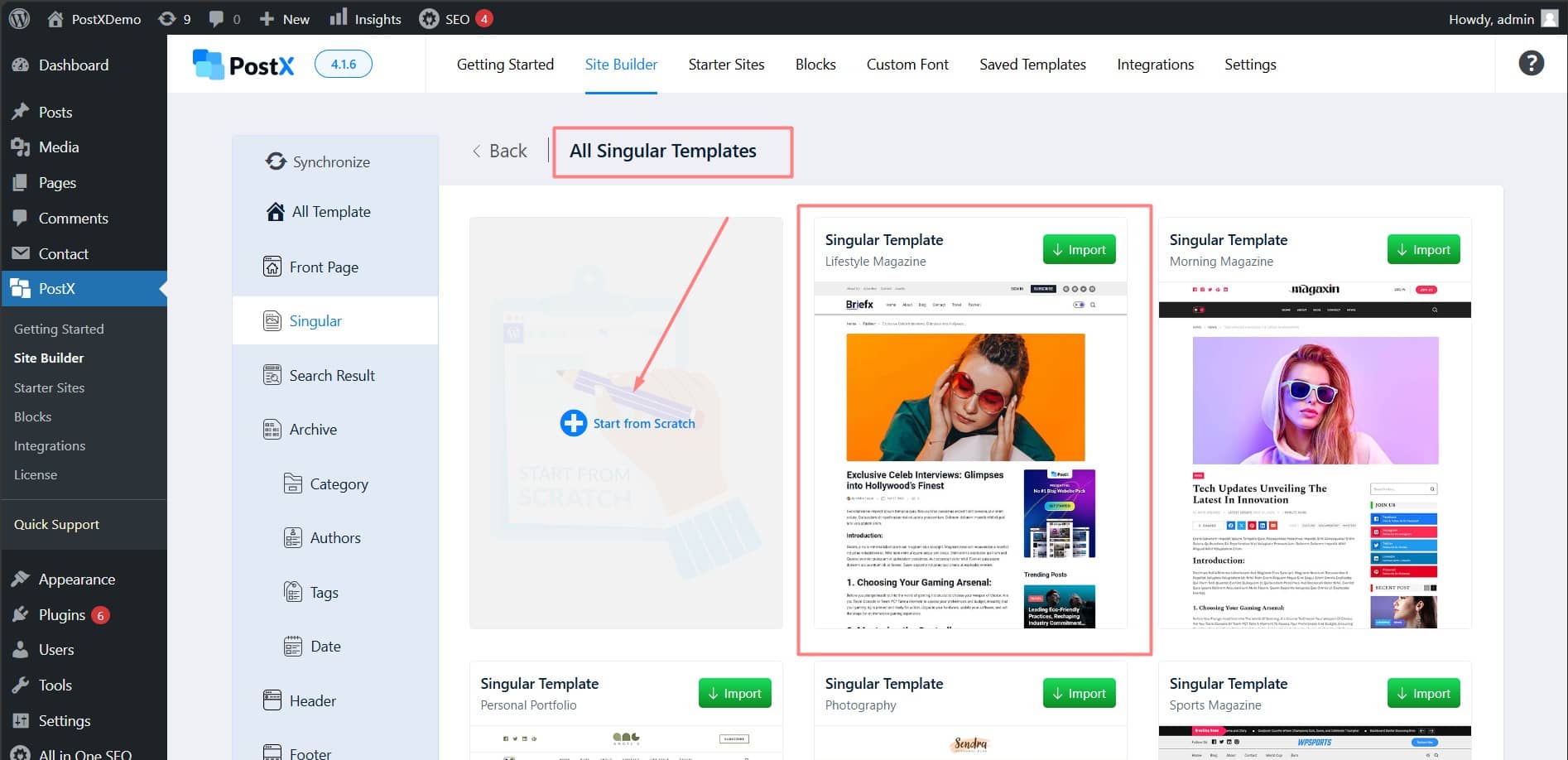
- After importing or creating a template, locate the ‘Condition’ section. Here, you can configure all the conditions to meet your site’s requirements.
- For example, select ‘Posts’ and ‘All’ as conditions to apply the template to all blog posts.
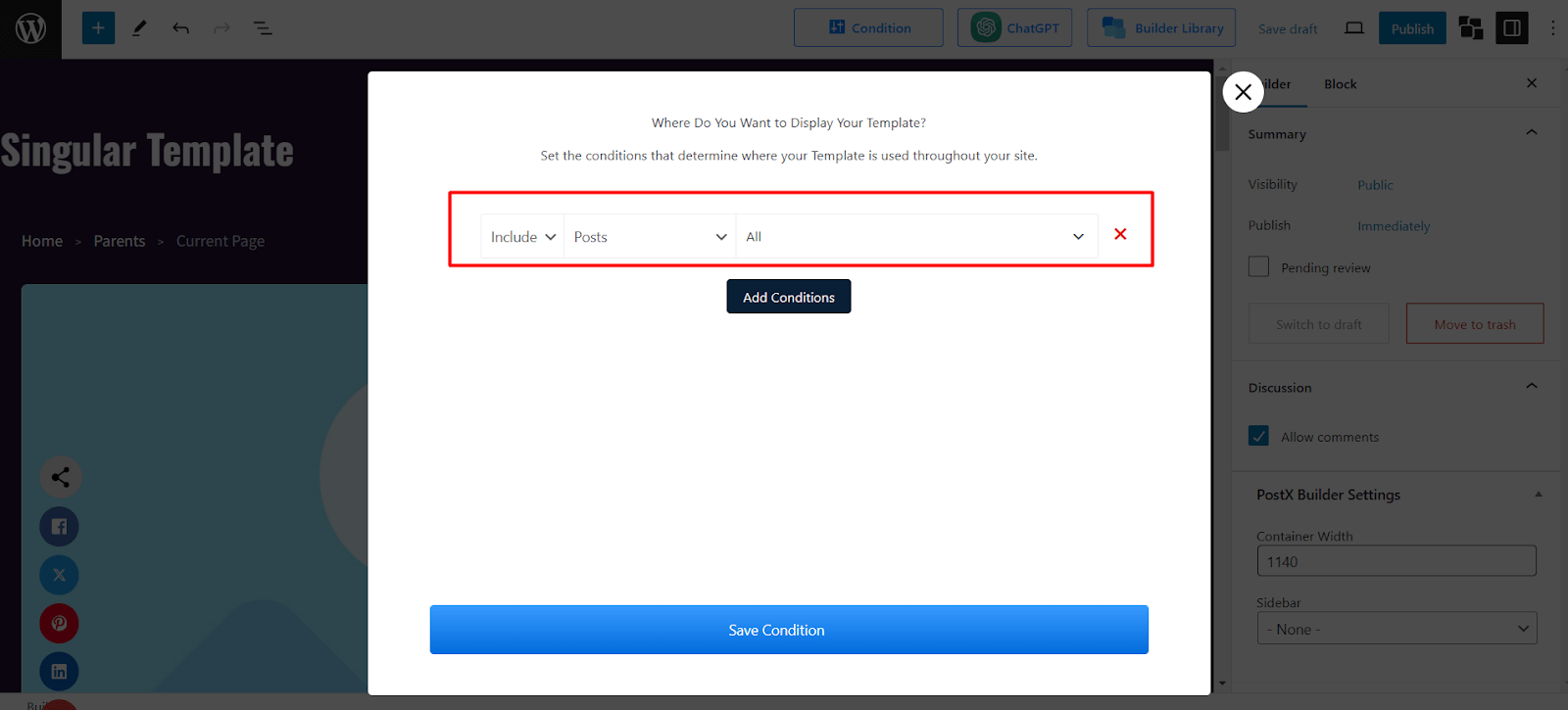
- Once you’ve selected the condition, click the Save Condition button.
- In the editor view, you can then freely add or modify blocks as you like.
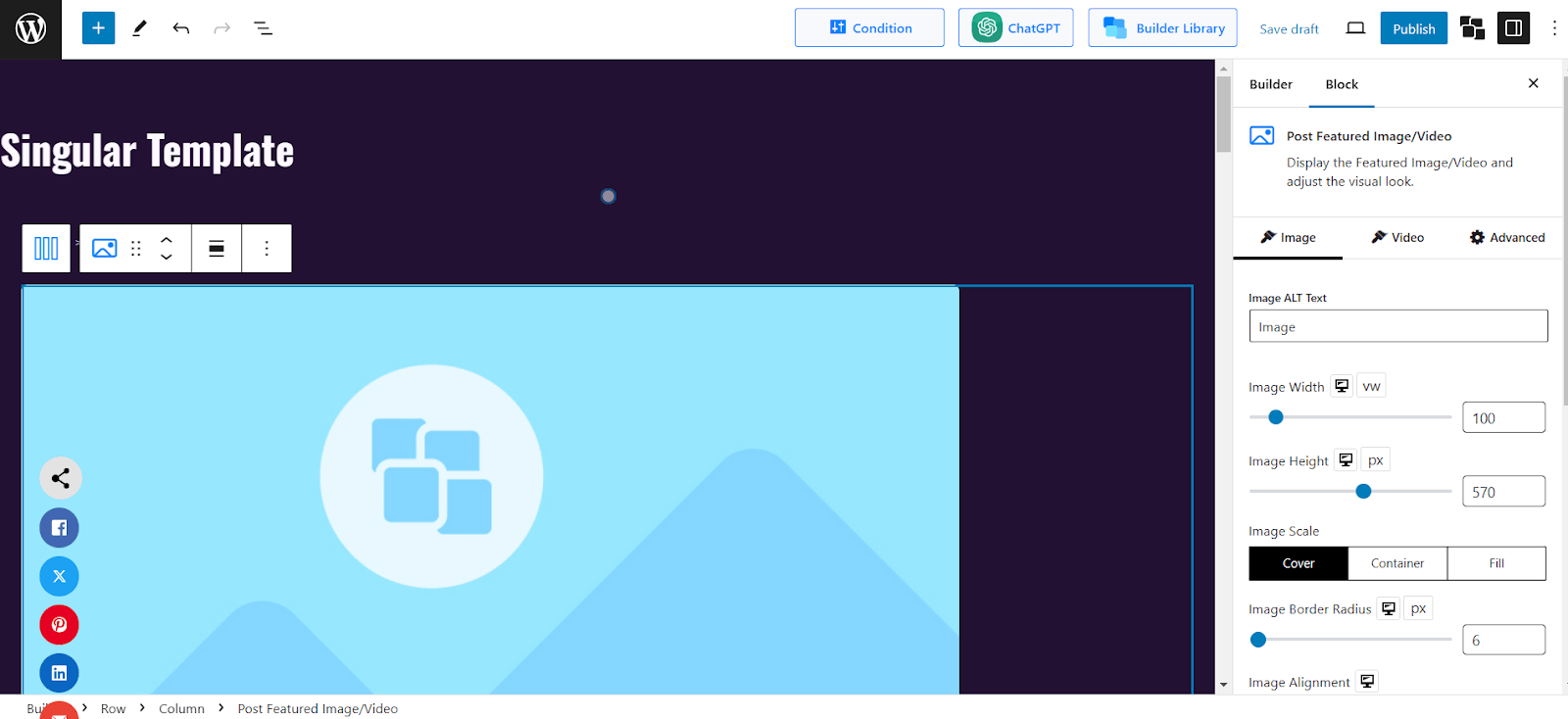
To change the post title color to green, follow these steps:
- Click on the Post Title block.
- Navigate to the color settings.
- Select the green color option.
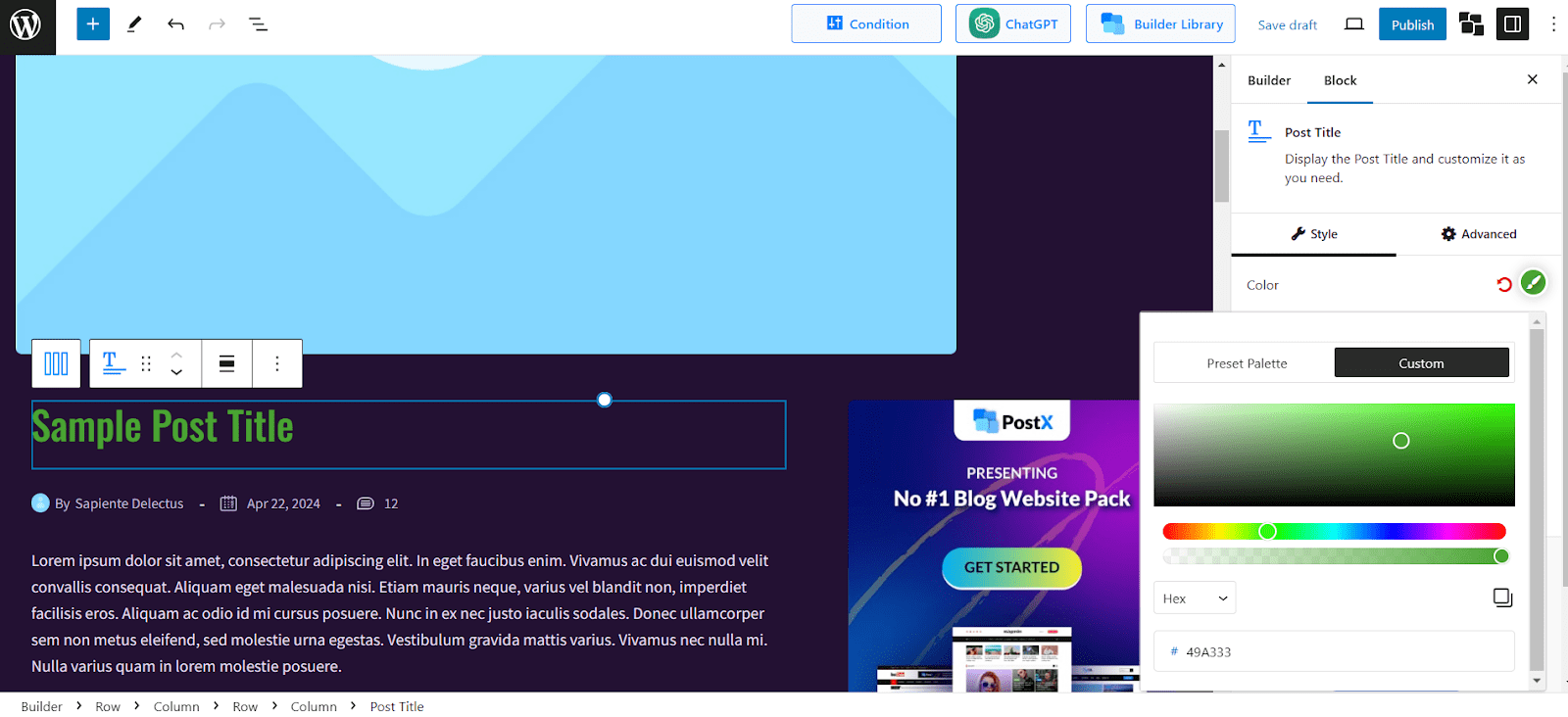
Next, hit the Publish button. This will update the post title color to green.
PostX is a versatile WordPress plugin that lets you customize your fashion blog to your exact needs.
Discover the incredible features this plugin offers and unlock your blog’s potential. Dive into PostX today.
Step 06: Prepare Your Footage and Content
Your website is ready, so start blogging now! You can experiment with different styles or topics at first, but remember to build trust with your audience. After your first post, keep writing consistently. Maintain regularity and quality.
Focus on these points:
– Showcase your unique personality.
– Begin with your best outfits and style sense.
– Be friendly and approachable.
– Prepare at least 15 to 20 pieces of content before launching.
Here are some more blog ideas and formats to consider:
- Top 10 Must-Have Fashion Items for Fall
- A numbered list of essential fashion items for the fall season.
- Hidden Gems: Underrated Fashion Brands to Discover
- Highlight lesser-known fashion brands that offer unique and stylish pieces.
- Budget-Friendly Fashion Hacks: How to Look Stylish on a Budget
- Provide practical tips and tricks for saving money on fashion.
- Cultural Influences: The History of [Fashion Trend]
- Explore the cultural and historical origins of a specific fashion trend.
- Must-Have Accessories to Elevate Any Outfit
- A collection of versatile accessories that can instantly enhance your style.
- Adventure Fashion: Styling Tips for Outdoor Activities
- Provide practical advice on dressing for outdoor adventures while staying stylish.
- Sustainable Fashion: Eco-Friendly Brands and Practices
- Discuss the importance of sustainable fashion and recommend eco-friendly brands.
- Best Time to Buy: Seasonal Fashion Sales and Discounts
- Provide a guide to the best times of year to shop for fashion deals.
Prepare Your Footage
Images and videos are essential for fashion blogging. You cannot build a strong connection or evoke emotions in your audience with text alone.
In fact, according to OptinMonster, articles with images receive 94% more views than those without, and videos are 50 times more effective at driving organic search traffic than plain text.
Here are some guidelines you should consider:
Invest in Quality Equipment: Consider getting a DSLR, ring light, tripod, or other gear to enhance your visuals.
Take Fashion Photography Courses: Invest in and join quality fashion photography courses to refine your skills.
Follow Fashion Photography Tips: Explore tips to improve your fashion photography techniques.
Use Stock Images: Utilize stock images until you capture fresh content at your next fashion shoot.
Edit Your Photos: Consider free photo editing software to filter and adjust your fashion shots.
Create Compelling Videos: Use a free video maker to craft engaging fashion-related videos.
Leverage Photo Tools: Use tools to organize and optimize your fashion content.
Step 07: Grow Your Audience And Connect with the Community
Building a successful fashion blog goes beyond creating content. You need strategic efforts to grow your audience and connect with like-minded individuals.
You can follow these points to expand your reach and establish a strong presence in the community.
Create an About Page: You can craft a compelling About page for your blog. This is often the most visited page and serves as an introduction to your identity and style. Keep it personal and friendly to showcase your authentic self.
Leverage Social Media: Social media platforms like Instagram, Pinterest, TikTok, and YouTube are essential for reaching your target audience. They help you connect with fellow fashion enthusiasts and build a community. Use these platforms to enhance your brand’s visibility.
Tip: Don’t rely solely on platforms like Instagram and TikTok, as they can change or lose popularity. Instead, create a website from the start to maintain control over your content.
Utilize Word of Mouth: Share your fashion blog with friends, family, and new acquaintances. You can mention it at events, boutiques, or fashion shows to spread the word. Word of mouth is powerful, so invite people to visit your blog whenever possible.
Build a Newsletter: Once you have steady visitors, encourage them to subscribe to your newsletter. This lets you engage your audience through email campaigns. Offer fashion tips, trends, and exclusive content directly to their inboxes.
Network with Other Bloggers and Communities: You can engage with other fashion bloggers and influencers by liking, commenting, and sharing their posts. Collaboration can strengthen your community and foster mutual growth.
Consider Pay-Per-Click Ads: PPC ads can attract a quality audience to your blog. They are more costly, so it’s best to avoid them when starting. Focus on organic growth first.
Optimize Your Site for SEO: SEO is vital for driving organic traffic to your blog. Write optimized, helpful content to improve your search engine ranking. This will help you reach a broader audience.
Partner with Fashion Brands: Monetization is key to sustaining your blog. Connect with fashion brands to promote their products and services. This generates revenue and enhances your blog’s credibility in the fashion industry.
Tips for Reaching Out to Brands:
– Identify the brands you want to partner with.
– Conduct thorough research to understand their audience’s needs.
– Craft a compelling pitch highlighting the services you can offer in exchange.
Step 08: Make Your Fashion Blog Profitable
When your fashion blog attracts a large audience, you can begin to monetize it. A fashion blog can be very profitable. It offers many ways to earn money and allows you to have multiple income streams.
Tip: Focus on growing your blog’s audience first. A larger audience boosts your earning potential. Building a loyal audience takes time, so prioritize engagement before monetization.
Here are some ways to monetize your fashion blog:
Publish Sponsored Posts: Sponsored posts are a main income source for fashion bloggers.
For example, you could write about a sustainable clothing brand and share how eco-friendly fashion has impacted your wardrobe. Always mention that the post is sponsored to keep your readers’ trust.
Showcase Ads: Displaying ads on your site is a popular way to make money. Most fashion blogs sell advertising. You can use Google Adsense or feature ads for local boutiques.
Start Affiliate Marketing: You can promote products on your blog and social media. Use a unique link to track sales. When someone buys through your link, you earn a commission.
Consider affiliate programs like ShopStyle, Amazon Fashion, ASOS, and Nordstrom.
Offer Premium Content: Create exclusive content for paying readers. This could include style guides, eBooks, or personal styling consultations.
For example, you could sell a PDF guide on how to build a capsule wardrobe for $5.
Take Donations: Many content creators accept donations to support their work. Don’t hesitate to ask for donations to keep providing quality content.
Arrange Workshops and Sell Courses: Share your fashion knowledge by offering workshops or courses.
For example, you could teach a course on how to shop effectively at thrift stores.
Sell Photos and Videos: Your fashion photos and videos can be sold if they are of high quality. They are valuable assets that can earn you money.
Sell Fashion-Related Products: Add an online shop to your blog. You can sell custom apparel, accessories, or styling tools. You can also set up a dropshipping website.
Step 09: Follow Other Fashion Bloggers for Inspiration
Following top fashion bloggers can boost your creativity and style. Observing how they showcase trends helps you refine your fashion blog and stay inspired. It’s a great way to stay engaged with fashion influencers and discover new ideas.
Here are some must-follow fashion bloggers:
Amani’s is a blog dedicated to hijab fashion and style. Explore hijab styles, outfit inspiration, and modest fashion tips for everyday life.
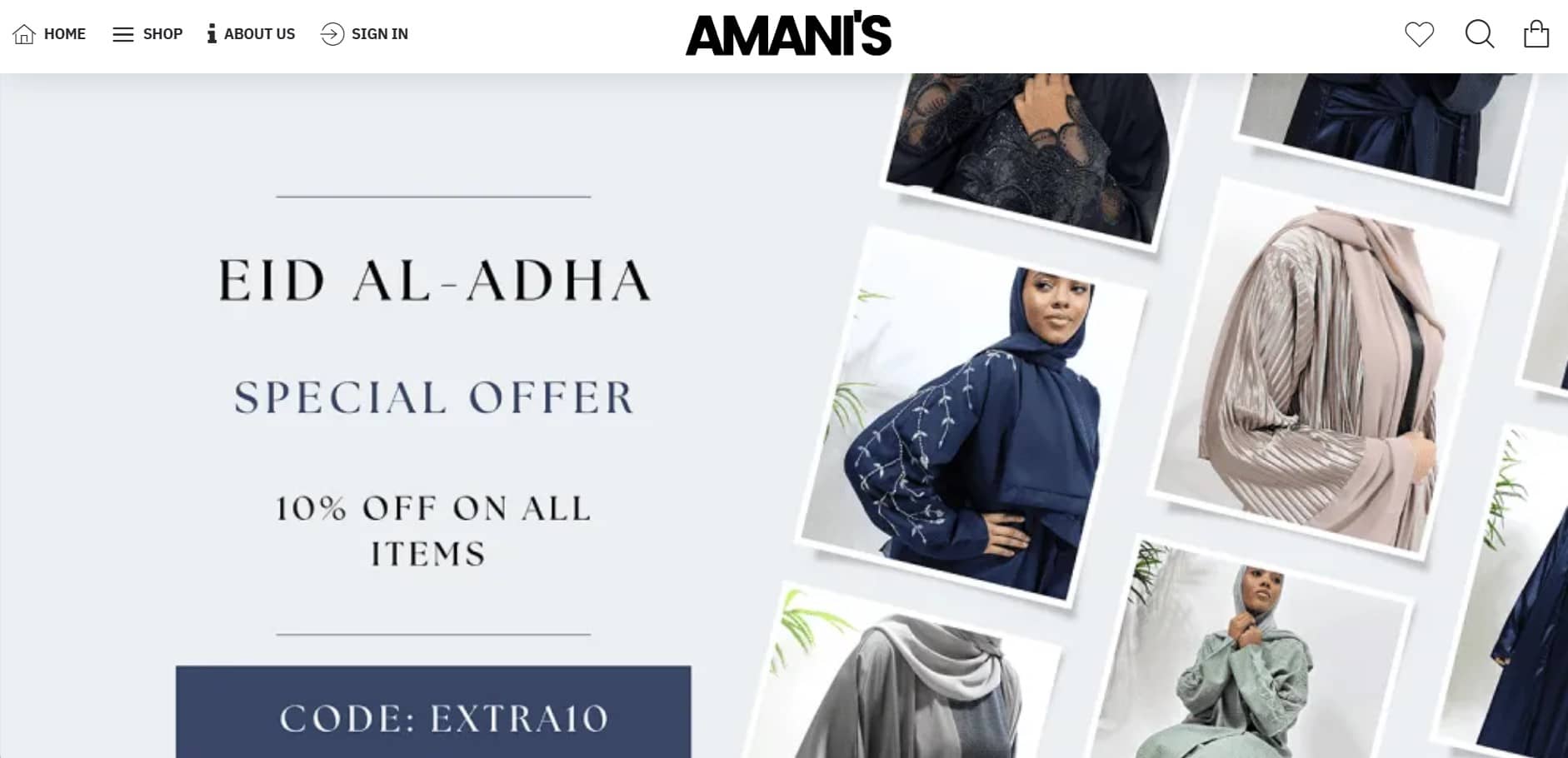
Joanna Goddard’s blog, Cup of Jo, offers a mix of fashion, lifestyle, and parenting content. Discover her personal style, outfit inspiration, and tips for balancing work, family, and fashion.
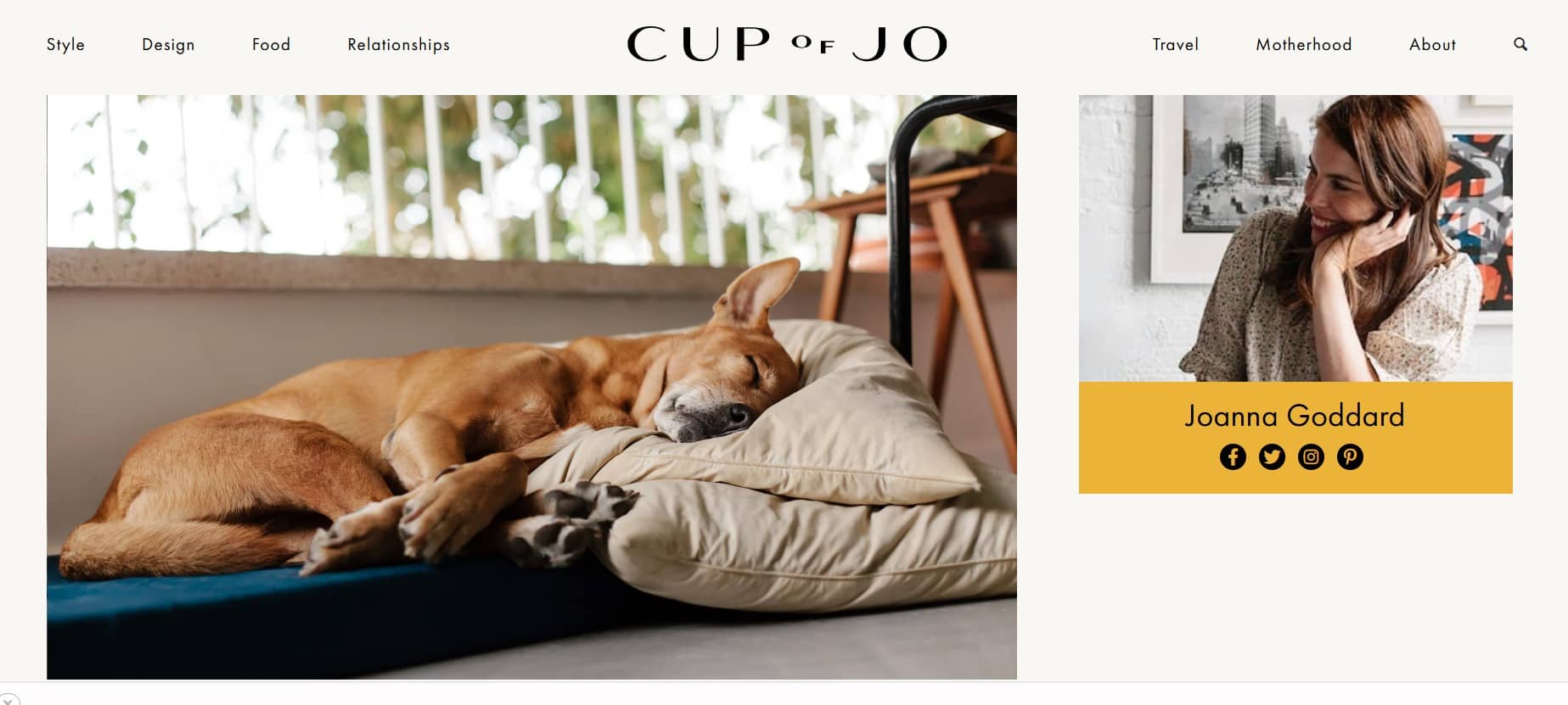
Jeff L. Rosen’s blog, Men’s Style Pro, offers practical advice and inspiration for men’s fashion. Discover outfit ideas, style tips, and grooming advice.
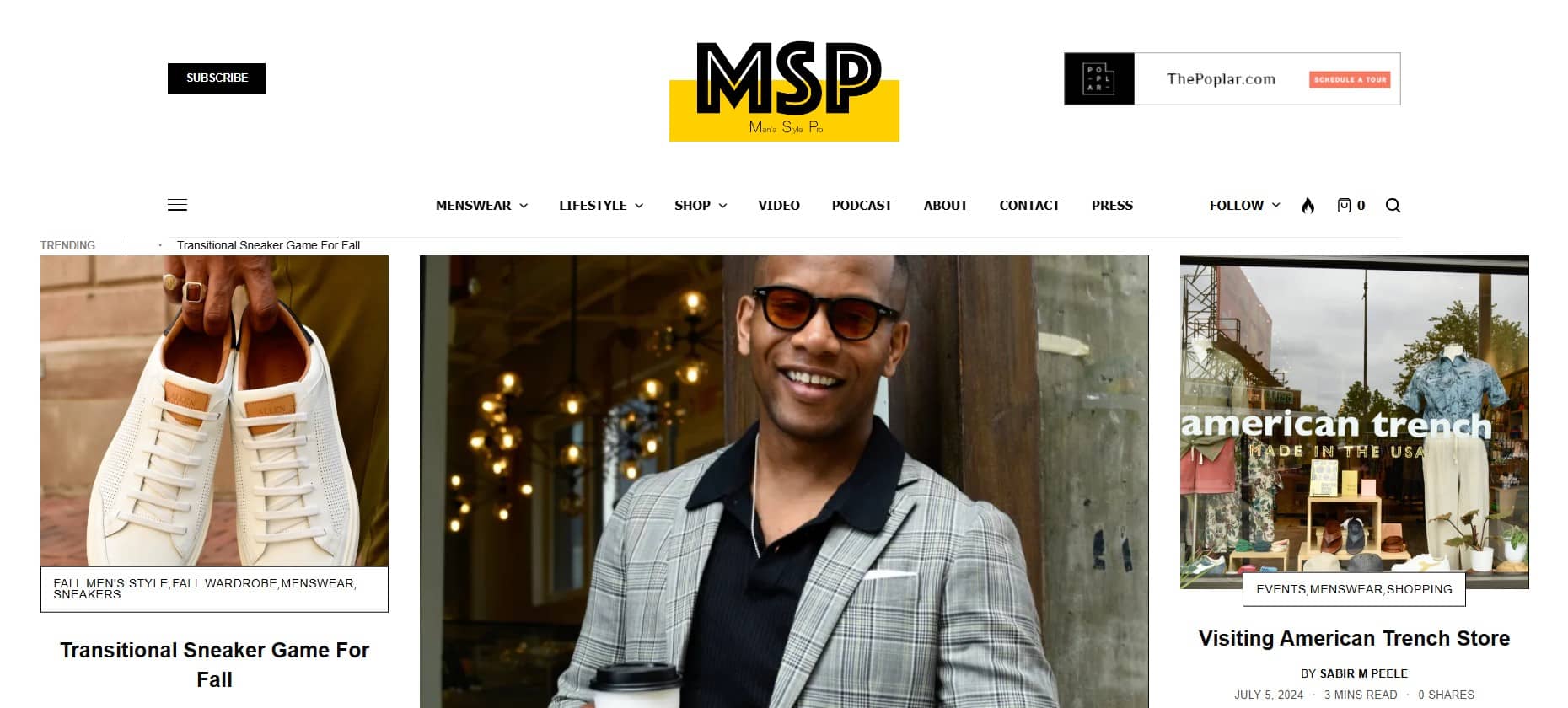
LivvyLand, a style blogger offers practical advice and inspiration for men’s fashion. Discover outfit ideas, style tips, and grooming advice.
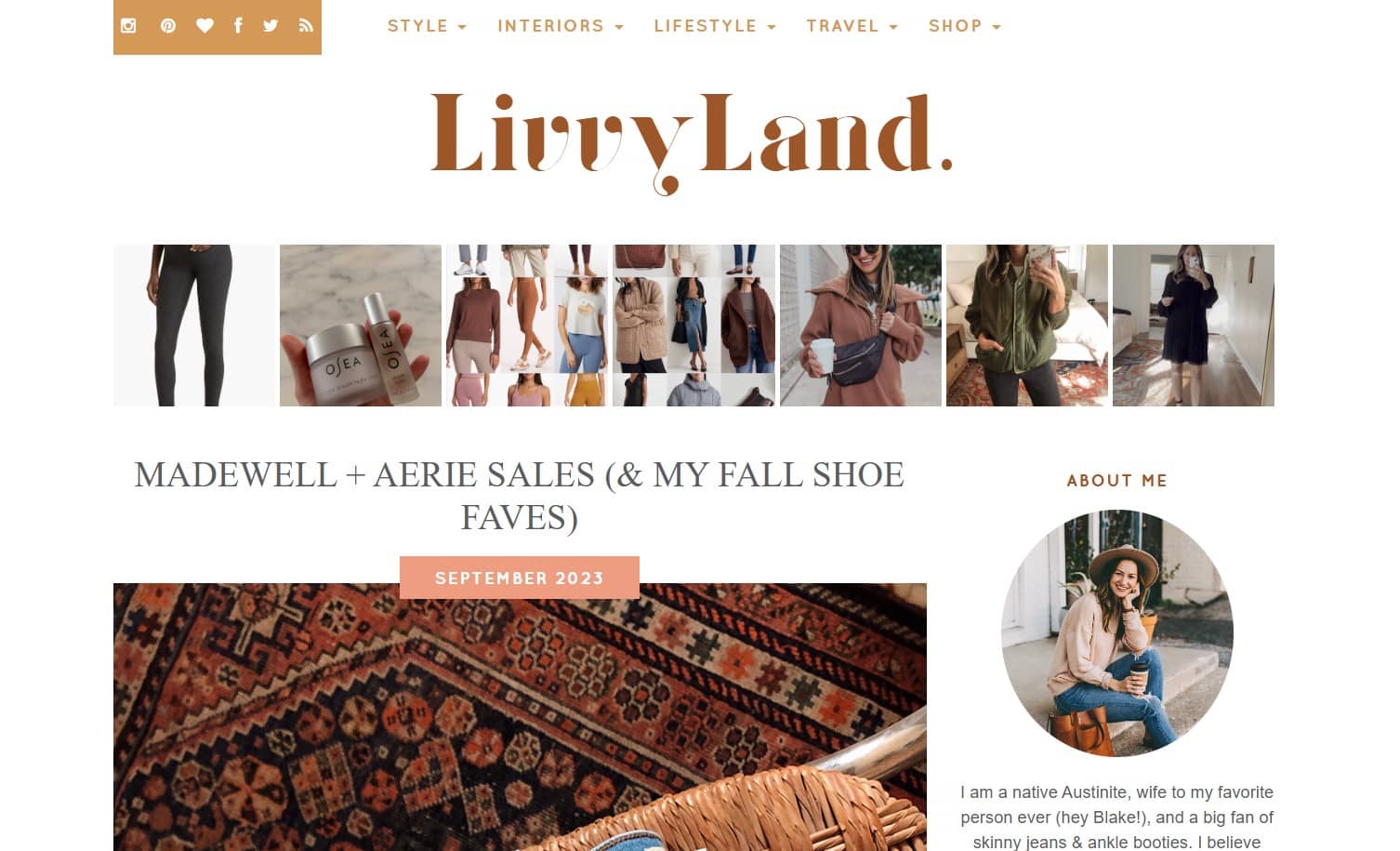
Resources You’ll Love
- How to start a blog
- How to start a travel blog
- How to start a gaming blog
- How to start a food blog
- How to start a news blog
Happy Fashion Blogging!
In conclusion, presenting a stylish and engaging fashion blog is essential for your blogging success. Always keep your readers updated on the latest trends, designer collections, and style tips they can embrace.
In this guide, I explained fashion blogs and provided a step-by-step approach to starting one. I introduced PostX as the most affordable and versatile site builder plugin for your fashion blog needs. Even with the free version, you have plenty of options.
I also emphasized the importance of choosing a relevant name and logo for your blog. I offered tips on selecting the perfect domain and hosting provider.
Finally, I shared strategies for engaging your audience and monetizing your fashion blog.
Best of luck with your fashion blog!
FAQs
How can I make money from my fashion blog?
You can earn money by showing ads, doing sponsored posts with brands, using affiliate marketing, selling fashion items, or offering styling services.
How much does it cost to start a fashion blog?
Starting a fashion blog doesn’t have to break the bank. Mainly, you’ll need to cover domain registration, hosting, and a blog plugin. You can use PostX to keep costs down and streamline your setup.
How much money can I make from a fashion blog?
Income from a fashion blog varies widely based on your blog’s traffic, engagement, and monetization methods. It can be a small side job or a full-time income.
Do I need professional photography skills?
While great photos help but they’re not everything. Good storytelling and valuable content can make a huge difference, too.
How often should I post?
You should post regularly, whether it’s weekly, bi-weekly, or monthly. But remember, quality is more important than quantity.
Do I need any equipment to start a fashion blog?
A laptop or smartphone is enough to start. As you grow, you might want a good camera and other tools.
Can I start a fashion blog without a lot of fashion experience?
Yes! Start by researching fashion trends, creating content, and sharing your style ideas. Real fashion experiences can come later.
